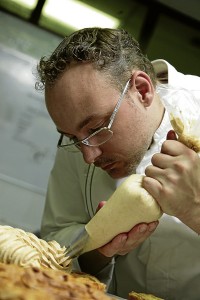
But beginners are never told technique that should likewise be learned—how to fold, how to beat, how to blend. Technique defines whether your pastry will be a delight or a disaster.
But there are bakers who go beyond the technique, and the result is an artistic piece that is as good as it looks. And some go beyond the bakery to become pastry chefs in professional kitchens.
One of them is Franck Geuffroy of the Alain Ducasse Foundation. After the normal culinary school training, he specialized in pastry because he liked the artistry and creativity. As a young student, he said he already loved to draw during art classes.
Chef Geuffroy conducted a pastry demonstration last month at the Enderun Colleges at the Fort in Taguig. The “Art of Pastry,” as the demo was called, began with him creating a centerpiece made of chocolate forms and pulled sugar that looked like glossy colorful clay pieces. He was constantly folding and turning the pulled sugar, and, yes, pulling.
The chef said that the more you work on the sugar, the shinier it gets. He combined red and green to make a ribbon. He used molds to produce leaves. He shaped petals that became a flower to be placed on the centerpiece.
Pulled sugar is hot when you work with it and so there are special gloves to protect the hands. Before the gloves were available, chefs handled the sugar with bare hands. I thought that an instant pulled sugar was also now available, but chef Geuffroy disabused me of that notion and told me he prepared the sugar early in the morning. The process is too long, he said, for a short demo.
Far more interesting for a beginner is how pastries are done by this French chef. Yet this chef decided to make simpler recipes, no complicated layered cakes or airy pastries. It was to demonstrate how Alain Ducasse likes simple recipes perfected. So there was Paris Brest, puff pastry (pâté à choux) shaped into a ring, cut in half crosswise.
Traditionally, it has praline cream and sliced almonds placed in between, but the chef decided to use Filipino ingredients such as coco jam, desiccated coconut and cashew nut.
Chef Geuffroy likes to use local ingredients like calamansi, finding the citrus a “pure gift from nature.” And the mangoes and pineapple are sweeter than any he has tasted. He will return to study the flowers, he said. It was suggested that he should try dayap, the local lime with a flowery aroma that is used in our desserts like pastillas and leche flan. You could see him making a mental note of that.
Candies, desserts
Has the chef been around to visit some of our local bakeshops or tasted locally made sweets (some were cited last week in this section’s “20 Best Desserts”)? Chef Geuffroy said he has been busy working. Those he has tasted he said were too sweet for him and he thinks he tried the Brazo de Mercedes when we described it.
Being French, I thought it would be interesting for him to know that one of our favorite desserts is called sans rival, described as layers of cashew meringue torte held together by a buttery sweet icing with rum. Nora Daza, in her book “A Culinary Life,” published a recipe called Gateau Sans Rival from an old recipe book of Le Cordon Bleu.
The pastry chef smiled and then declared that he will create a recipe to rival that. We are waiting.
E-mail pinoyfood04@yahoo.com.